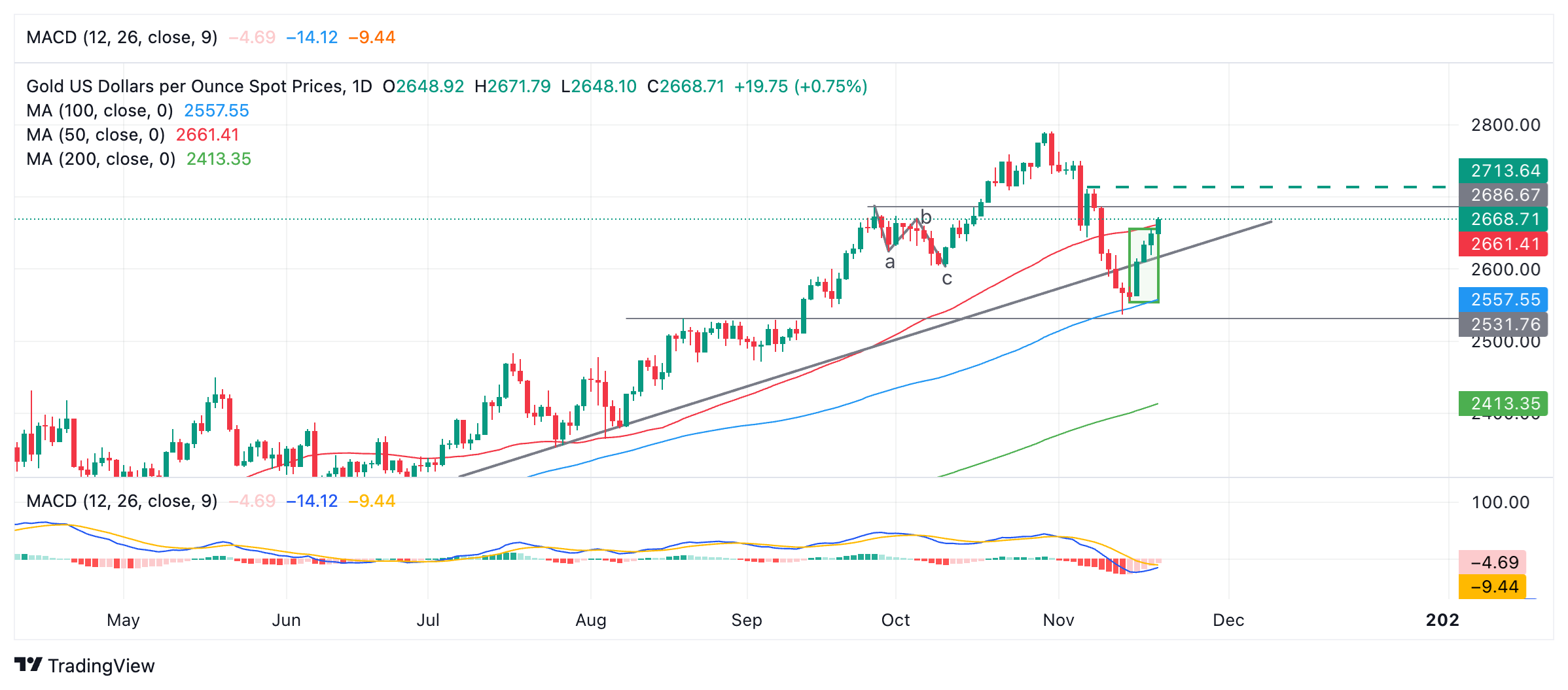Gold rallies on dovish Fedspeak and geopolitical tensions
- Gold rises for the fourth day in a row on Thursday as traders reach for safety.
- Underwhelming Nvidia earnings, talks about cutting interest rates from Fed speakers and Russia-nuke risks all impact.
- XAU/USD forms a bullish Three White Soldiers Japanese candlestick pattern.
Gold (XAU/USD) extends its recovery into a fourth day on Thursday, rising up into the $2,660s. An overall risk-off tone to markets due to disappointment at Nvidia’s results is weaning investors off stocks and catalyzing safe-haven flows into Gold.
Thursday’s mildly weaker US Dollar (USD) is a further tailwind for Gold since it is mostly priced and traded in USD. Continued haven flows from geopolitical fears relating to Russia’s lowering of the threshold for using nuclear weapons is another factor.
Capping gains for the precious metal, however, is competition from Bitcoin (BTC). According to Bloomberg News, a surge in Bitcoin Exchange Traded Fund (ETF) inflows in November – ETFs enable investors to own shares that track BTC’s price rather than owning the asset itself – has coincided with a similar surge in outflows from Gold ETFs. This suggests a direct pivot away from owning Gold and into Bitcoin.
Gold extends reversal after Nvidia earnings release
Gold is pushing higher on Thursday after the third quarter earnings release from Nvidia triggered a decline in stock markets. Although Nvidia’s Q3 earnings beat estimates and were initially met with euphoria, the stock itself slumped 3.0% following the release.
The unintuitive response was put down to the results not quite being good enough to match “the sky-high expectations for the AI colossus,” according to Forbes. The overall risk-off tone left in the wake of the disappointment led to a broad decline in investor sentiment, which for Gold and other safe-haven assets was positive news.
The US Dollar (USD), meanwhile, is edging slightly lower after surging on Wednesday. The Greenback appears to have been stopped in its tracks by commentary from Federal Reserve (Fed) speakers suggesting the Fed should push ahead with its plan to cut interest rates amid falling inflation. This goes surprisingly against the widespread view that inflation will rise under a Trump presidency.
Bank of New York President John Williams said he “sees inflation cooling and interest rates falling further,” in an interview with Barron's on Thursday. This followed similar comments from Federal Reserve Bank of Boston President Susan Collins, who said on Wednesday that more interest-rate cuts are needed, but policymakers should proceed carefully.
Technical Analysis: XAU/USD paints three white soldiers marching higher
Gold rises for the fourth consecutive day and paints a bullish “Three White Soldiers” Japanese candlestick pattern (green rectangle on the chart below) from last week’s lows.
XAU/USD Daily Chart
Gold has broken clearly back above a major long-term trendline and is attempting to break above the (red) 50-day Simple Moving Average (SMA) at $2,661. These are bullish signs.
The precious metal’s short-term trend is bullish, and given the maxim that “the trend is your friend,” the odds favor a continuation higher. The next target to the upside lies at $2,686, the September 26 high.
That said, the precious metal is in a downtrend on a medium-term trend, raising risks for the outlook. It is in an uptrend on a long-term basis, however, which supports the bullish shorter-term view.
Fed FAQs
Monetary policy in the US is shaped by the Federal Reserve (Fed). The Fed has two mandates: to achieve price stability and foster full employment. Its primary tool to achieve these goals is by adjusting interest rates. When prices are rising too quickly and inflation is above the Fed’s 2% target, it raises interest rates, increasing borrowing costs throughout the economy. This results in a stronger US Dollar (USD) as it makes the US a more attractive place for international investors to park their money. When inflation falls below 2% or the Unemployment Rate is too high, the Fed may lower interest rates to encourage borrowing, which weighs on the Greenback.
The Federal Reserve (Fed) holds eight policy meetings a year, where the Federal Open Market Committee (FOMC) assesses economic conditions and makes monetary policy decisions. The FOMC is attended by twelve Fed officials – the seven members of the Board of Governors, the president of the Federal Reserve Bank of New York, and four of the remaining eleven regional Reserve Bank presidents, who serve one-year terms on a rotating basis.
In extreme situations, the Federal Reserve may resort to a policy named Quantitative Easing (QE). QE is the process by which the Fed substantially increases the flow of credit in a stuck financial system. It is a non-standard policy measure used during crises or when inflation is extremely low. It was the Fed’s weapon of choice during the Great Financial Crisis in 2008. It involves the Fed printing more Dollars and using them to buy high grade bonds from financial institutions. QE usually weakens the US Dollar.
Quantitative tightening (QT) is the reverse process of QE, whereby the Federal Reserve stops buying bonds from financial institutions and does not reinvest the principal from the bonds it holds maturing, to purchase new bonds. It is usually positive for the value of the US Dollar.
